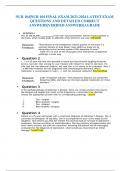Tentamen (uitwerkingen)
SOLUTION MANUAL for Introduction to Probability Models 12th Edition by Ross Sheldon. | All Chapters 1-12
- Vak
- Instelling
- Boek
SOLUTION MANUAL for Introduction to Probability Models 12th Edition by Ross Sheldon. ISBN 3476, ISBN-13 978-9.TABLE OF CONTENTS_ 1. Introduction to Probability Theory 2. Random Variables 3. Conditional Probability and Conditional Expectation 4. Markov Chains 5. The Exponential Distribution and the ...
[Meer zien]













